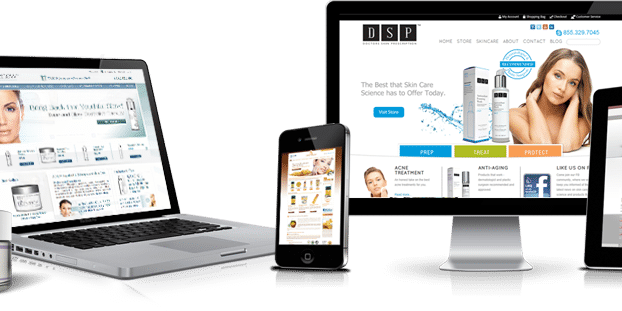 In the skincare industry, a well-designed website is crucial for attracting customers, building trust, and driving sales. A skincare website must do more than showcase products—it should offer an engaging and seamless shopping experience that converts visitors into loyal customers. By combining aesthetics, functionality, and strategic design elements, your website can become a powerful sales tool. Here’s how to design a skincare website that effectively sells products. Get the facts here on skin care website design that sells products. Find out how proper websites can sell beauty products better.
In the skincare industry, a well-designed website is crucial for attracting customers, building trust, and driving sales. A skincare website must do more than showcase products—it should offer an engaging and seamless shopping experience that converts visitors into loyal customers. By combining aesthetics, functionality, and strategic design elements, your website can become a powerful sales tool. Here’s how to design a skincare website that effectively sells products. Get the facts here on skin care website design that sells products. Find out how proper websites can sell beauty products better.
Prioritize Mobile-First Design
With most online shoppers using mobile devices, a mobile-first design is essential for any skincare website. A responsive website ensures that your content adjusts to various screen sizes, providing a smooth and enjoyable browsing experience for all users.
Optimizing for mobile includes features such as easy navigation, quick loading times, and thumb-friendly buttons. Because mobile users expect fast, seamless interactions, a mobile-friendly design helps reduce bounce rates and increase conversions.
Showcase High-Quality Product Images
Visual appeal plays a significant role in skincare purchases, as customers want to see the texture, color, and packaging of your products. Use high-quality images that showcase products from multiple angles and include zoom functionality for close-up details.
In addition to static images, consider incorporating videos or GIFs that demonstrate how to use your products. Because visual content builds trust and confidence in your offerings, investing in professional photography and engaging visuals is key to boosting sales.
Create Clear and Compelling Product Descriptions
Customers need detailed information to make informed purchasing decisions. Write clear, concise, and engaging product descriptions that highlight key benefits, ingredients, and usage instructions. Avoid overwhelming users with jargon—use language that resonates with your target audience.
For example, instead of simply stating “moisturizer with hyaluronic acid,” explain how it hydrates and plumps the skin. Including information about your brand’s unique selling points, such as being cruelty-free or dermatologist-tested, also helps differentiate your products.
Optimize Navigation and Search Functionality
An intuitive navigation structure helps visitors find what they’re looking for quickly and easily. Organize your product categories logically, such as “Cleansers,” “Moisturizers,” and “Serums,” and use drop-down menus to simplify navigation.
Additionally, a robust search functionality with filters (e.g., skin type, concerns, or price) improves the shopping experience. Predictive search suggestions and sorting options further enhance usability, making it easier for customers to locate and purchase products.
Leverage Customer Reviews and Testimonials
Social proof is a powerful motivator for skincare shoppers. Include customer reviews, testimonials, and before-and-after photos on your product pages to showcase real-life results. Highlight positive feedback and include ratings or star systems to make it easy for customers to evaluate your offerings.
By featuring authentic customer experiences, you build trust and reassure potential buyers of your product’s effectiveness.
Incorporate Personalized Product Recommendations
Personalization enhances the shopping experience by tailoring suggestions to individual needs. Use data-driven tools to recommend products based on a visitor’s browsing history, preferences, or previous purchases.
For example, if a customer views a cleanser for oily skin, suggest complementary items like a toner or moisturizer designed for similar skin types. Personalized recommendations increase the likelihood of cross-selling and upselling, boosting overall sales.
Highlight Sustainability and Transparency
Today’s skincare consumers value brands that prioritize sustainability and transparency. Use your website to communicate your commitment to eco-friendly practices, such as recyclable packaging, ethically sourced ingredients, or cruelty-free certifications.
Consider adding a “Sustainability” or “Our Values” section to share your story and mission. Being transparent about your practices not only builds trust but also strengthens your brand’s connection with environmentally conscious customers.
Streamline the Checkout Process
A complicated checkout process is one of the leading causes of cart abandonment. Simplify the process by minimizing the number of steps and offering a guest checkout option. Clearly display shipping costs, delivery timelines, and return policies upfront to avoid surprises.
Integrating multiple payment options, such as credit cards, PayPal, and digital wallets, also ensures a smoother checkout experience. A streamlined process encourages customers to complete their purchases and reduces friction at the final stage.
Use Engaging Calls-to-Action (CTAs)
Strategic calls-to-action (CTAs) guide visitors through the buying journey and encourage them to take action. Use clear, action-oriented language like “Add to Cart,” “Shop Now,” or “Get Glowing Skin Today” to prompt users to make a purchase.
Place CTAs prominently on product pages, in navigation menus, and throughout your website to ensure visibility. Because effective CTAs drive engagement and conversions, they are an essential element of your site’s design.
Optimize for Search Engines (SEO)
Search engine optimization ensures your skincare website ranks highly in search results, attracting more organic traffic. Use relevant keywords in product titles, descriptions, and meta tags to align with customer search queries.
Additionally, create SEO-friendly content such as blog posts or guides that address common skincare questions. For example, an article on “How to Build a Skincare Routine for Dry Skin” can drive traffic while positioning your brand as an authority in the industry.
Build an Engaging Blog or Resource Section
Educating customers about skincare benefits, routines, and ingredients enhances their shopping experience. A blog or resource section on your website allows you to share valuable information that drives traffic and builds trust.
For instance, write articles about the benefits of vitamin C for the skin or seasonal skincare tips. High-quality, informative content establishes your brand as a trusted resource, increasing customer loyalty and encouraging repeat visits.
Ensure Fast Loading Times
Page speed is critical for user satisfaction and search engine rankings. Slow-loading pages can frustrate visitors and lead to higher bounce rates. Compress images, reduce code bloat, and use a reliable hosting service to ensure fast load times.
Since speed directly impacts conversions, optimizing your website’s performance improves both user experience and sales.
Incorporate Live Chat and Customer Support
Offering live chat functionality allows customers to ask questions in real time, reducing hesitation and building confidence in their purchases. Whether they need help choosing a product or understanding its benefits, prompt assistance improves their experience.
Additionally, clearly display customer support contact options, such as email or phone numbers, to make help easily accessible. Providing excellent support fosters trust and encourages customer loyalty.
Monitor Analytics and Optimize Regularly
Use analytics tools to track key metrics like page views, bounce rates, and conversion rates. Regularly analyze this data to identify areas for improvement, such as refining product descriptions, simplifying navigation, or adjusting CTAs.
Continuous optimization ensures your skincare website stays competitive and meets evolving customer expectations.
Conclusion
A well-designed skincare website is a powerful tool for attracting customers, building trust, and driving sales. By prioritizing mobile responsiveness, high-quality visuals, personalized recommendations, and a seamless checkout process, you create an engaging shopping experience that converts visitors into loyal buyers. With thoughtful design, transparency, and continuous optimization, your website can become a cornerstone of your skincare brand’s success. Get the facts here on skin care website design that sells products. Find out how proper websites can sell beauty products better.








